7 Tips to Provide World-class Customer Service on Twitter (That Work)
Customer service is an important topic. If you do it well, you’ll get rewarded for it, but if you do it poorly, the news will spread fast.
There’s not much more annoying than sitting in a long phone line when calling a customer service number or sending an email to a customer service department only to get a response days or even weeks later. If you recognize yourself in providing this type of customer service, let me tell you that it leaves your customers angry, feeling ignored and forgotten.
The difference from customer service back in the days is that customers aren’t voiceless anymore. Now, they can get their voice heard with social media.
That’s not all. Now, you can get your voice heard with social media as well!
More specifically Twitter.
How?
By using it as a customer service tool!
We are seeing a clear change in social media.
What was just a few years ago a place where people only shared selfies and quotes have now become a tool for brand outreach and customer service. If you want to stay relevant in this ever-changing world, offering what your audience want is crucial.
- 33% of users prefer to contact brands through social media rather than telephone
- An estimated 67% of consumers now tap networks like Twitter and Facebook for customer service.
- In the past two years, the number of Tweets directed at leading brands’ customer service usernames has grown by 2.5x
Twitter is a social platform designed to use on the go and to share posts within seconds. This makes Twitter the ultimate customer service tool, considering the fact that Forrester has found that 77% of adults online in the US say that the most important thing a company can do is value their time and provide them with fast responses.
People are clearly turning to social media for customer service, and not being there to help them out can seriously harm your brand. Make sure you are present to listen to them and follow these 7 Tips to Provide World-class Customer Service on Twitter (That Work)
1. Have a structure and strategy
Customer service needs great planning in order to be good. What is someone mentions you and you miss out on what they had to say simply because you have too many notifications.
On Twitter, you also want to keep track of those you have spoken to in a record. If a customer decides to respond back after several days and you don’t remember who they are and what issue they had, it will get embarrassing. Especially if you will have to ask again what problem they had. It just shows that you don’t care about them.
Therefore, you want to write down every single customer service interaction you’ve had, take notes of their Twitter handle, their issue, and what date they contacted you on.
2. Create a customer service account
We can see this getting more and more common, even to the point where some of the largest corporates are implementing it.
The reason to why you want to create a Twitter account particularly for customer service is to separate business and pleasure. It also gives your audience a clear source to reach out to you with, since your name should explicitly say “customer service/support”.
Having a customer support account lets you filter out inquiries regarding support from your regular account, letting you be even quicker and agile in your responses.
H&M offers customer help with their Twitter account particularly dedicated for customer service. What’s more, they are offering the service in 20 languages!
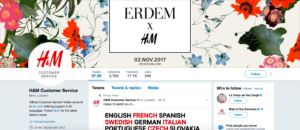
Comcast has also created a customer service account on Twitter.

3. Never ignore negative feedback
This is a major mistake a lot of brands do.
Ignoring negative feedback can and will result in more damage than the one that has already been done.
Instead, take this opportunity to get insight into where your brand can improve, and what pains your customers are experiencing with your brand.
“
When customers share their story, they’re not just sharing pain points. They’re actually teaching you how to make your product, service, and business better. Your customer service organization should be designed to effectively communicate those issues.
”
If you ignore customers’ complaints, they will leave your brand 91% of the time, and not do business with you willingly. Succeed in solving a complaint and the customer will do business with you again 70% of the time.
When working with Twitter support and you get messages and inquiries that let you know about pain points customers are facing with your brand, use the strategy/structure list to write down valuable information you are getting.
At the end of the week or month, go through the list of complaints that held any real value when it comes to improving, and see if there’s anything you can do about the problem your customers were facing so that you can make sure it will never happen again.
If you want to further nourish a relationship with your audience, and increase their passion for your brand, mention the people who addressed the problem that you’ve now solved in a tweet, thanking them for letting you know about the issue.
This will now only show the customer who was once angry that you care about them and what they have to say, but it will also show the rest of your audience that you take customer service and improvement very seriously.
4. Respond to every single message
Your customers are reaching out to you for a reason. They need help solving a problem they have faced with your brand. Or, they might just reach out to you because they have a simple question.
Or maybe, they just want to praise you for creating great products!
Whatever the case might be, responding to your customers is vital for your retention.
People want you to respond, and if you do, they’ll get happy!
In fact, 86% would be happy to receive a response back. However, only 33% receives a response. As a result of a response, 3 out of 4 are somewhat or very satisfied.
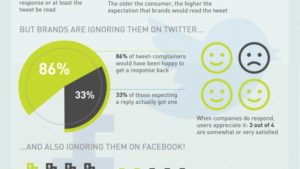
Whether it be answering your customer’s question or solving a problem they have faced, responding is tremendously important and will further help your retention rate.
5. Put more resources into your Twitter support
If you don’t have the resources to respond to the number of messages you are receiving on Twitter, it’s important that you assort more resources to it.
Fast replies generate revenue.
Read that again.
It seems like many brands aren’t aware of this.
Or maybe they are aware of it but just don’t care?
A study shows that when an airline responded to a customer’s tweet within 6 minutes, the customer was willing to pay $20 more for that airline in the future.
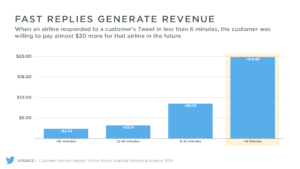
Quite a significant number as a result of a single response!
If you don’t have the resources to respond to your customer’s messages, you might just be better off not having Twitter at all. This way, you’ll direct them to your traditional customer service sources. Or.. they might just end up skipping to contact you because of all the hassle in doing so using the traditional outreach tools.
Or.. they might just end up skipping to contact you because of all the hassle in doing so using the traditional outreach tools.
They might just end up skipping to contact you because of all the hassle in doing so using the traditional outreach tools.
It is your choice, however, considering the statistics about Twitter as a customer service tool in the beginning of this article, it is quite obvious that you’ll gain more by prioritizing putting in more resources than to ignore it completely.
48% of customers are expecting a response from brands in less than 1 hour. The faster response you’ll provide them with, the happier they’ll get.
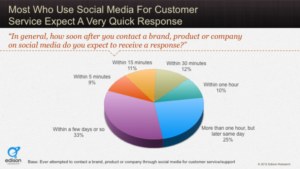
6 . Use their names and your name
If you have multiple people working on your Twitter customer service, adding your name at the end of each message can help you keep track of who wrote what.
The other benefit of including your own name in the message is that it helps build a relationship with the customer you are talking to, and makes the conversation more personal. Nobody likes talking to a fancy logo and a brand name, right?
Last but not least, your customers have names 100% of the times, and they like to hear it. When you are using their name, the conversation instantly gets a whole lot more personal.
If you don’t want to use your full name, you can just your initials. Of course, this makes it difficult for your customers to talk to you using your name, however, this is especially beneficial if you have a large team working on it.
Amazon Help ends all their replies with initials. As you can see, they are all different, which means they probably have a large team, thus making the use of initials instead of names a wise choice for tracking.
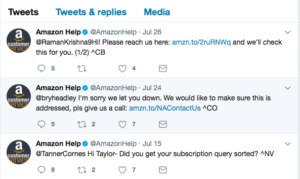
7. Monitor Tweets
Over 1 million people view tweets about customer service every week. Around 80% of those tweets have a negative or critical nature.
Monitor what your customers are writing about your brand on Twitter and respond to them as quickly as you can before they turn into a social media storm. See the complaints as an opportunity to “Wow” your audience, and not an opportunity to apologize for the inconvenience the issue has caused your customer.
People don’t want to hear brands come up with excuses or apologies. They want to see brands come up with solutions! But if you aren’t listening to what your audience has to say and what problems they’re facing, how can you possibly know?
The best ways to stay alerted of new brand mentions and discussions about your brand are the following:
- Constantly check your notifications (and activate them if you haven’t).
- Track @mentions of your brand.
- Regularly check #hashtags of your company name.
- Search for common misspellings of your company name so you aren’t missing out on messages if people have misspelled it.
- Have notifications enabled both for your desktop apps and mobile.
Conclusion
Customer service is something that brands must take seriously. If you succeed in providing this to customers, they’ll love you forever, and you’ll dramatically increase the chances of them becoming repeat customers and recommending your brand to their peers.
As the way customers are reaching out to brands are changing, you must adapt in order to be able to quickly adapt address and solve any problems or questions they may have.


